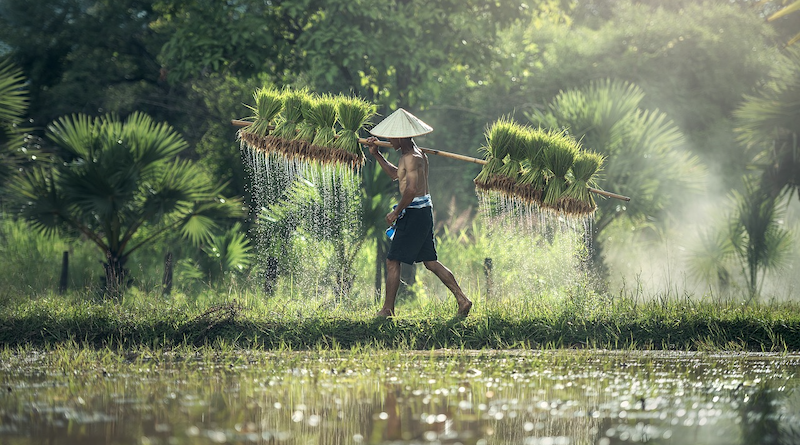Tags
In Thailand’s Deep South, Farmers Fight To Restore Vanishing Paddy Fields

By Asmadee Bueheng
In the lush landscape of Thailand’s Deep South, a quiet revolution is brewing. A network of farmers and activists is breathing new life into abandoned rice fields – and preserving local culture as they go along.
The grassroots movement is encouraging young people to return to their forgotten family fields, build granaries and harvest rice for community lunch programs.
“In the past, working-age individuals had to leave to find jobs elsewhere, leaving only children and the elderly in the community. Bringing them back home to the farm revitalizes the community,” said Fareesy Maka, a project committee member at the Narathiwat Abandoned Rice Fields Restoration Network.
Thailand is the world’s sixth largest rice-producing nation, according to U.S. Department of Agriculture research. But many small-scale farmers in Thailand’s south say they are struggling to survive.
Rising costs for fertilizers, competition from big agricultural companies, and increasingly variable weather patterns driven by climate change are putting the squeeze on small farms. At the same time, the labor pool is drying out as young people leave for better job opportunities across the border in Malaysia.
“Despite villagers’ efforts to grow rice alongside other economic activities, they still can’t generate enough income to support their families,” said Sukri Mama, the coordinator of the Narathiwat Abandoned Rice Fields Restoration Network.
As a result, the rice paddies that once blanketed the Deep South – the provinces of Pattani, Yala, Narathiwat and four districts of Songklha province near the Malaysia border – are slowly disappearing.
In 2011, Narathiwat province had 86,600 rai (about 34,640 acres, or 14 hectares) under rice cultivation, but a decade later that had fallen to 84,700 rai, according to the Ministry of Agriculture and Cooperatives.
In Yala province, paddy fields declined from 52,500 rai in 2011 to 47,600 rai in 2021. The drop was even more pronounced in Pattani, with the area under rice cultivation shrinking from 144,000 rai in 2011 to 94,600 rai a decade later.
Preserving culture
As the paddy fields disappear, some older residents are beginning to worry about the future of their communities.
Aminah, 60, a farmer from Enor village in Narathiwat province, said it was “increasingly hard to find the next generation of farmers.”
“Growing rice brings a sense of security and our ancestors told us never to abandon it,” Aminah, who only gave her first name, told BenarNews.
She said she joined the restoration network to provide guidance on rice cultivation and land management.
“Revitalizing abandoned rice fields and protecting the mountains is crucial for the community’s overall stability,” she said.
In Enor village, some 17 rai of abandoned paddies have been restored over the past five years, yielding an average of 50 sacks of rice annually.
While the program helps sustain livelihoods, Fareesy said it was also about preserving the south’s distinct Melayu culture, of which Islam is a central part.
Four out of five residents in the Deep South identify as Muslim, while 93.4% of Thailand’s population is Buddhist.
Enthno-religious tensions, repression by Buddhist-majority national authorities and poverty are at the heart of a decades-long conflict between separatists and the government in the region.
Using local rice varieties and traditional farming techniques, especially those that don’t rely on toxic pesticides, was a way to fight repression, said Fareesy.
The ecological balance
Restoring rice paddies with traditional farming methods has benefits for the environment too, according to Kua Rittiboon, an assistant professor of ecology at Prince of Songkla University’s Pattani campus.
“Revitalizing rice fields and local ecosystems is valuable as they provide food, habitats, and beautiful landscapes that protect against disasters,” she told BenarNews.
She added it also helped support the ecological balance between people and nature.
After finding success in Narathiwat province, the initiative has expanded to neighboring Pattani.
A project in Kok Nibong village has to date restored a relatively small 10 rai of abandoned paddy fields. But that includes plots farmed by both Muslims and Buddhists.
“Even though outsiders might view Buddhists and Muslims as being at odds with each other, we are friends and farmers who help each other, sharing both happiness and suffering,” said Marasri, a 70-year-old Buddhist farmer in the village. “Drought and the rainy season do not discriminate based on religion.”
In Kok Nibong, the restoration network has reintroduced native rice varieties such as Hom Chan, Leb Nok and black rice. After each harvest, the seeds are carefully collected and stored in granaries, all with an eye on the future.
“We hope that one day our children will return to revive their grandparents’ rice fields,” said Marasri.
https://www.eurasiareview.com/13072024-in-thailands-deep-south-farmers-fight-to-restore-vanishing-paddy-fields/Published Date: July 13, 2024






